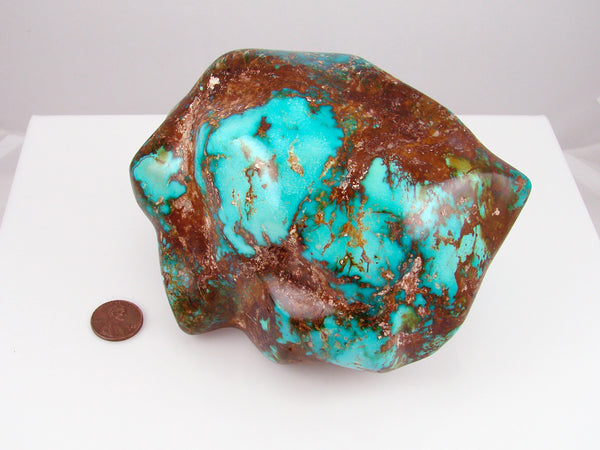About Turquoise

Few things in the Southwest are as iconic as turquoise Native American Indian jewelry. This striking blue gemstone has truly stood the test of time, appearing in American Indian jewelry as early as 1600 CE in Santo Domingo Pueblo (Kewa) and weaving its way through generations of artists, traders, and collectors, and into the hands of modern-day fashionistas.
Turquoise has been cherished and used by the Southwest Native American tribes for centuries in trade, for ceremonial purposes, and to enhance their beautiful art forms -- from sandpaintings to jewelry.
While the thought of turquoise to many people conjures up images of Native American jewelry, turquoise is found in many places around the world. As far back as the 14th century, the people of Turkey were known for their taste for the mineral, so much so that the French named the stone after them: turquoise.

Spiritual Significance
Nearly every Native American tribe has made some use of turquoise, whether for healing or aesthetic purposes. Perhaps due to its reminiscence of sky and water - two sacred elements here in the Southwest - this rare blue-green gemstone carries spiritual significance for many of the tribes in this region.
Turquoise took on special meaning for the Navajo (Diné) people, specifically, as one of the four sacred stones of the Navajo tribe. Along with White Shell, Abalone, and Jet, these stones are associated with the Four Sacred Mountains, which form the traditional boundaries of Navajoland. The southern Mt. Taylor (Tsoodził) is represented by blue turquoise in Navajo religious ceremonies. Sheepherders carry a fetish carving made from turquoise to ensure the fertility of their sheep; hunters to ensure success in the hunt; and warriors to ensure victory and a safe return. Turquoise is undoubtedly more than just a stone for many Native Americans and jewelry collectors.

History of Turquoise
Due to its tremendous importance to so many Native American (and non-native) peoples, turquoise has been mined in great amounts over the years. Throughout the Southwest, more than 200 prehistoric mines have been located -- some of which were being worked as early as 300 CE. Many Native myths and legends included turquoise: the gods had playthings, ornaments, weapons, and even houses made of turquoise. Medicine men, caciques, and shamans could not carry out their duties properly without turquoise. Indeed, few rites, festivities, or religious ceremonies took place without the official use of turquoise in some way.
During the 18th and 19th centuries, as tribes began to develop their own styles and methods of jewelry making, turquoise became the most popular stone to appear in Southwest Indian jewelry. Because of its early prominence, turquoise will continue to be a representation of Native American cultures and traditions for years to come, and it is certain to be showcased and preserved by beautiful, one-of-a-kind pieces of jewelry.

Technically Speaking...
Turquoise is classified as a secondary mineral, forming fine-grained, solid veins in broken igneous rock, or irregular cavities in deeply altered rocks. It usually occurs within limonite, kaolinite, quartz, chalcedony, or sericite. Heres how:
Turquoise is deposited by descending surface waters, usually acidic, which percolate through seams in the bedrock during the weathering and oxidation of pre-existing minerals. The formation of turquoise only takes place in arid desert climates and is usually found near the surface of the ground.
The color of turquoise varies greatly from off-white to dark blue and can be nearly 200 different shades of blue and green, depending on the mineral content of the host stone. Generally speaking, higher copper content will yield a more blue turquoise stone while higher zinc content shows up as a greener turquoise. When set in jewelry, this porous gemstone absorbs oils from the wearers skin and deepens to a green-blue color, as can be seen in many of our vintage pieces.
So that turquoise ring your grandmother gave you? Odds are, it truly is one-of-a-kind both in craftsmanship and its chemical makeup.

Learn More:
- The Turquoise Mineral Group
- What is the difference between stabilized and natural turquoise?
- Turquoise Chart
- If you are interested in learning more about turquoise, we highly recommend reading Turquoise Unearthed by Joe Dan Lowry, widely regarded as one of the world's most knowledgeable experts on the stone.
Major Turquoise Mines of the American Southwest







Cam you tell where to find a chart of the difference mines and a sample of the turquoise i have alot don’t know what mine or what kind of turquoise it is.
Thank you for your time
Lori
Leave a comment